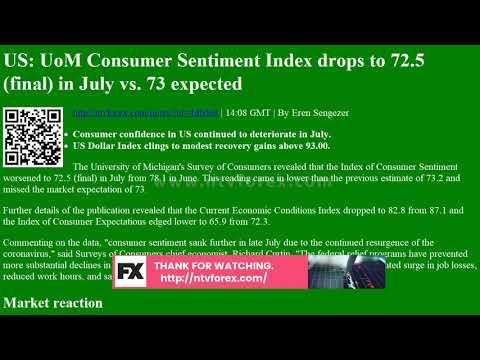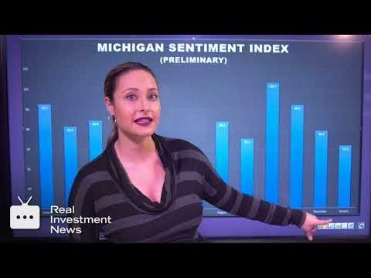Michigan Sentiment Index
Table of Contents Heading
- Market Overview
- University Of Michigan Consumer Sentiment Index Leads U S. Unemployment Rate
- Consumer Sentiment Index From University Of Michigan
- University Of Michigan Consumer Sentiment Misses Expectations
- Subscribe To The Fred Newsletter
- Historical Data
- Michigan Consumer Sentiment Index
The consumer confidence measures were devised in the late 1940s by Professor George Katona at the University of Michigan. They have now developed into an ongoing, nationally representative survey based on telephonic household interviews. The Index of Consumer Sentiment is developed from these interviews. The Index of Consumer Expectations (a sub-index of ICS) is included in the Leading Indicator Composite Index published by the U.S. The University of Michigan Consumer Sentiment Index is a consumer confidence index published monthly by the University of Michigan.

Meanwhile, expectations were revised higher to 70.7 from 69.8 but remained below 74 in January and the current conditions gauge fell to 86.2 from 86.7, the same as in the preliminary estimate. Inflation expectations for the year ahead increased to 3.3% from 3% in the previous month while the 5-year outlook was unchanged at 2.7%, matching initial figures. “While consumers clearly anticipate a spurt in inflation in the year ahead, the overall evidence does not indicate the emergence of an inflationary psychology that makes the expectation of inflation a self-fulfilling prophecy”. The US Index of Consumer Sentiment , as provided by University of Michigan, tracks consumer sentiment in the US, based on surveys on random samples of US households.
Market Overview
These include white papers, government data, original reporting, and interviews with industry experts. We also reference original research from other reputable publishers where appropriate. You can learn more about the standards we follow in producing accurate, unbiased content in oureditorial policy. Since January 2015, Index data is available from multiple sources including University’s website, Bloomberg, and Macrobond.
Economists had predicted the unemployment rate would instead hit 19%, rivaling the worst days of the Great Depression. One possible problem in this moded is that we dont’t deal with the seasonal behavior via SARIMA model. But in the future, it’s possibe for me to consider more about the seasonal change and how to remove this seasonality as well. From output of ARMA model, the absolute value roots of the AR polynomial are 1.4, 1.0, 1.0. two of three are close the unit circle, suggests we may have a non-causality issue from this model. In addition, the absolute value roots of the MA are 0.91, 1.46, 0.91.
University Of Michigan Consumer Sentiment Index Leads U S. Unemployment Rate
There are many theories why the economy develops cyclically, one of them is the Austrian business cycle theory. The gold – business cyclelink is one of the more important fundamental issues that one needs to analyze when taking long-term investment decisions. The university’s gauge of current economic conditions jumped to 87.5 from 82.9. The Index of Consumer Expectations rose to 73.5 from 68.5, also hitting its highest since March. On a positive note, the university’s measure of current economic conditions only fell 0.5 points, to 86.2. The measure was likely bolstered by the accelerating pace of vaccination and declining COVID-19 case counts.
These are the core obsessions that drive our newsroom—defining topics of seismic importance to the global economy. And while they are optimistic that jobs are coming back, many consumers still see a hard slog ahead, Curtin noted. The University of Michigan’s consumer-sentiment index posted its biggest gain in four years, hitting 78.9 in June, a 9.1% gain over May, and marking its second month of improvement.
Consumer Sentiment Index From University Of Michigan
Subscribe to Axios Markets for the latest market trends and economic insights. Republican critics of the measure said the bill was too expensive, skewed towards liberal policies like expanding coverage of the Affordable Care Act, and unnecessary considering signs of increasing economic revival. Economists surveyed by Bloomberg estimated that the November sentiment gauge would hold at 95.5. Consumer expectations for inflation in the year ahead were unchanged at 2.5%, with five-year estimates rising to 2.4% from 2.3% in October. Fed policy makers have been concerned that inflation is persistently below their target. The interview period from Oct. 22 to Nov. 6 included last week’s packed calendar for economic news, and the Fed’s third-straight interest-rate cut. The reports showed steady economic growth and hiring, while Washington and Beijing moved closer toward a trade agreement.
Americans are growing increasingly optimistic toward the US economy’s future as reopenings continue and new COVID-19 infections fall. The September reading is “consistent with an unchanged flat trend” that could be thrown off by the US presidential election’s outcome or delays in rolling out a coronavirus vaccine, Curtin added. It indicates a way to close an interaction, or dismiss a notification. By clicking ‘Sign up’, you agree to receive marketing emails from Insider as well as other partner offers and accept our Terms of Service and Privacy Policy.
University Of Michigan Consumer Sentiment Misses Expectations
It contains federal funds for individual stimulus payments, an extension of expanded unemployment benefits through September, and money for state governments, schools, restaurants and other businesses. A measure of buying conditions for household durable goods slipped to 153 from 160, about in line with this year’s average. Sentiment that an agreement with China was near contributed to increased sentiment. DisclaimerAll content on this website, including dictionary, thesaurus, literature, geography, and other reference data is for informational purposes only. This information should not be considered complete, up to date, and is not intended to be used in place of a visit, consultation, or advice of a legal, medical, or any other professional. Another factor fueling the optimism, the survey noted, has been the move by states across the country to reopen their economies.
History shows that consumer confidence has been at its lowest point just prior to and in the midst of recessionary periods. The index rises when consumers regain confidence in the economy, which portends increased consumer spending and thus economic growth. This growth, in turn, leads to greater interest from foreign investors, which results in the increased value of the dollar against other foreign currencies. Historically speaking, the value of the dollar has usually risen whenever the Michigan CSI has come in at a higher level than was anticipated and fallen when the index came in lower. The University of Michigan’s consumer sentiment for the US jumped to 83 in March of 2021 from 76.8 in February, beating market forecasts of 78.5, preliminary estimates showed.
Subscribe To The Fred Newsletter
Consumers across the U.S. are feeling more optimistic as the economy reopens, a new survey finds. Receive full access to our market insights, commentary, newsletters, breaking news alerts, and more.
The authors find that measures available from the Conference Board have both economically and statistically significant explanatory power for several categories of consumer spending. By contrast, measures available from the University of Michigan generally exhibit weaker forecasting power for most categories of spending. As part of their analysis, the authors examine the ways in which the surveys underlying these measures differ and test whether certain types of survey questions are particularly important for predicting consumer spending.
Historical Data
Thus, we would say ARMA model in convenience but actually it is an ARIMA model based on not transformed data. gives us enough evidence to reject the NH and it suggests us differenced data is more suitable in our model.
That broadly fits in with inflation expectations on Wall Street, with the massive fiscal stimulus and pent-up demand for services as COVID-19 cases subside seen unleashing faster economic growth. Indeed, a separate survey by the Federal Reserve Bank of Philadelphia on Friday showed forecasters expected stronger economic growth over the next three years than they did when they were polled last quarter. Connecting decision makers to a dynamic network of information, people and ideas, Bloomberg quickly and accurately delivers business and financial information, news and insight around the world. Surveys have demonstrated their ability to accurately anticipate changes in interest rates, unemployment rates, inflation rates, GDP growth, housing, car demand and other key economic measures.
Michigan Consumer Sentiment Worse Than Expected
The Consumer Price Index , the Producer Price Index and Gross Domestic Product all forecast the future health of the U.S. economy. The Michigan Consumer Sentiment Index is another key indicator designed to illustrate the average U.S. consumer’s confidence level.

Finally,we will further assess whether monthly consumer sentiment exhibits certain cyclical or periodic behavior so that we could add SARIMA model to adjust our seasonality change. The average length of the stochastic cycles will be obtained and hence, we could validate the model by comparing the predicted values to the actuals. The University of Michigan’s consumer sentiment index dropped to 79.2 early this month from a final reading of 80.7 in December. Economists polled by Reuters had forecast the index would be little changed at 80. The University of Michigan’s consumer sentiment index dropped to 79.2 early this month from a final reading of 80.7 in December. It was so severe partly because banks ceased to trust each other. The level of consumers’ confidence is very important economic indicator, as well.
The index of current economic conditions edged down to 86.2 from 86.7 in January. But the index of consumer expectations — a measure of what consumers expect in six months — dropped to 69.8 from 74 last month, the weakest reading in six months. U.S. consumer sentiment regarding expectations for the next six months fell to a six-month low in February as Americans — particularly lower-incomer consumers — grew more pessimistic about their financial outlook. The month’s gains were primarily driven by improvements to consumers’ economic outlooks. Democrats’ view of economic prospects improved, while Republicans’ outlook weakened. The University of Michigan’s consumer sentiment index jumped more than expected in a preliminary September reading as Americans’ views of the US economic recovery improved.
The survey’s one-year inflation expectation rose to 3.3%, the highest since July 2014, from 3.0% in January. These factors helped to absorb the pandemic’s negative impact on the economy as well as on personal finances. The Consumer Confidence Index is a survey that measures how optimistic or pessimistic consumers are regarding their expected financial situation. Whenconsumer confidence increases, certain sectors tend to benefit sooner than others. Companies that provide consumer goods often reap the initial fruits of improved consumer sentiment. Consumers who feel more confident about the economy generally also feel better about their employment prospects and are therefore more willing to buy houses, cars, appliances and other items.

